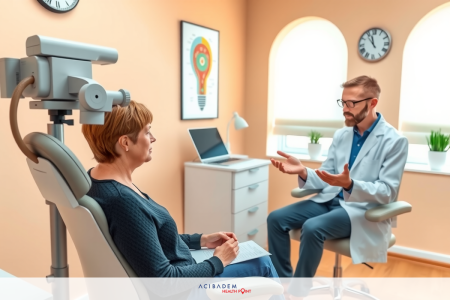Exotropia Vs Amblyopia Differences
Exotropia Vs Amblyopia Differences While both conditions impact vision, they have distinct characteristics and require different approaches to diagnosis and treatment.
Exotropia refers to a condition where the eyes are misaligned, causing one or both eyes to turn outward. It is a type of strabismus, which is a general term for eye misalignment. On the other hand, amblyopia, also known as lazy eye, is a condition where one eye has reduced vision, often due to an underlying eye disorder.
Recognizing the symptoms of these visual impairments is crucial in seeking appropriate care. Exotropia commonly presents with an obvious outward deviation of the eyes, which can lead to double vision and strain on the visual system. Amblyopia, on the other hand, often results in poor depth perception and reduced vision in one eye.
Treatment options for exotropia and amblyopia vary depending on the severity of the condition and the individual’s specific needs. For exotropia, corrective lenses, eye exercises, and in some cases, surgical interventions may be recommended. Amblyopia, on the other hand, can be managed through patching therapy, corrective lenses, and vision therapy.
Understanding the distinctions between exotropia and amblyopia is essential for individuals and caregivers. While they may share similarities, their underlying causes, symptoms, and treatment approaches differ significantly. By seeking expert care from the Acibadem Healthcare Group, individuals can access the specialized services and comprehensive treatment options necessary to address their specific visual impairments.
Understanding Exotropia
Exotropia, also known as outward eye misalignment or strabismus, is a visual impairment that affects eye alignment. In this condition, one or both eyes deviate outward, causing a noticeable misalignment. Exotropia can impact visual perception and overall visual function.
Individuals with exotropia often experience the outward deviation of one or both eyes, resulting in an apparent misalignment. This misalignment can vary in severity, ranging from intermittent to constant exotropia. It may affect one eye more prominently than the other, leading to a difference in visual input from each eye.
This eye misalignment can contribute to various symptoms, including double vision, reduced depth perception, and eye strain. The brain may struggle to fuse the images from both eyes into a single, clear vision, leading to visual discomfort and decreased visual acuity.
To better understand exotropia, it is essential to recognize its causes. The condition can be present from birth or develop later in life. Some common causes of exotropia include muscle imbalance, refractive errors, or neurological conditions.
Symptoms of Exotropia:
- Outward deviation of one or both eyes
- Double vision
- Poor depth perception
- Eye strain or discomfort
- Difficulty focusing
Early detection and intervention are crucial for managing exotropia effectively. An eye care professional, such as those at Acibadem Healthcare Group, can diagnose and offer appropriate treatment options based on individual needs. These may include eyeglasses or contact lenses to correct refractive errors, vision therapy to strengthen eye muscles, or in some cases, surgical procedures to realign the eyes.
By addressing exotropia promptly, individuals can enhance their visual function and overall quality of life. Seeking expert care is vital in ensuring comprehensive evaluation, accurate diagnosis, and personalized treatment plans.
| Exotropia | Amblyopia (Lazy Eye) |
|---|---|
| Affects eye alignment | Affects vision in one or both eyes |
| Outward deviation of one or both eyes | Reduced vision in one eye |
| May result in double vision and poor depth perception | May lead to decreased visual acuity and poor visual development |
| Treatment options include eyeglasses, vision therapy, and surgery | Treatment options include patching therapy, corrective lenses, and vision therapy |
Exploring Amblyopia
Amblyopia, commonly known as lazy eye, is a visual impairment that affects the development of clear and sharp vision in one or both eyes. It is one of the most common pediatric eye disorders, affecting approximately 2-3% of children. Amblyopia occurs when the brain favors one eye over the other, leading to reduced visual acuity in the weaker eye.
The underlying causes of amblyopia can vary, but they often involve conditions that affect the eye’s ability to focus, align, or perceive visual stimuli correctly. These conditions can include strabismus (eye misalignment), significant differences in refractive error between the eyes, or congenital cataracts. The brain responds to these visual irregularities by suppressing the input from the affected eye, resulting in diminished visual acuity.
Amblyopia typically develops during early childhood when the visual system is still developing. If left untreated, it can lead to permanent visual impairment and affect the child’s overall eye health. Therefore, it is essential to detect amblyopia early and initiate appropriate treatment to prevent long-term consequences.
| Signs and Symptoms of Amblyopia: |
|---|
| Reduced visual acuity: The affected eye may have blurry or unclear vision, even with the use of corrective lenses. |
| Poor depth perception: Amblyopia can affect the eyes’ ability to work together, leading to difficulty judging distances and perceiving three-dimensional space. |
| Squinting or closing one eye: Children with amblyopia may often squint or close one eye to compensate for the reduced visual acuity in the affected eye. |
| Head tilting or turning: Some children with amblyopia may exhibit head tilting or turning in an attempt to find the best viewing angle. |
| Poor visual integration: Amblyopia can impact the brain’s ability to process visual information, leading to difficulties in recognizing shapes, objects, or letters. |
Early detection and prompt treatment are crucial for managing amblyopia. Treatment options may include patching therapy, where the stronger eye is patched to stimulate visual development in the weaker eye, and vision therapy exercises aimed at improving the coordination of both eyes. In some cases, corrective lenses may be prescribed to address any refractive errors contributing to the amblyopia.
By understanding amblyopia and its impact on childhood visual development, parents and healthcare professionals can work together to detect and treat this visual impairment early, minimizing its long-term effects and ensuring optimal visual outcomes for children.
Symptoms of Exotropia
Exotropia, a form of eye misalignment also known as strabismus, can lead to various visual impairments and noticeable symptoms. The primary symptom of exotropia is the outward deviation of one or both eyes, causing the affected eye(s) to point away from the nose. This misalignment can result in double vision and difficulty focusing on objects. Individuals with exotropia may also experience eye strain, headaches, and decreased depth perception.
In addition to the distinctive eye misalignment, there are often associated symptoms that may accompany exotropia. These include:
- Intermittent eye deviation: The outward turning of the eye(s) may occur intermittently, with the misalignment becoming more pronounced during periods of fatigue, stress, or when focusing on objects up close.
- Squinting or closing one eye: To compensate for double vision or to alleviate visual discomfort, individuals with exotropia may squint or close one eye while looking at objects.
- Eye muscle fatigue: Prolonged misalignment can cause the eye muscles to tire easily, leading to increased strain and discomfort.
- Reduced fine motor skills: Children with exotropia may experience challenges in activities that require good hand-eye coordination, such as writing or drawing.
If you or your child are displaying any of these symptoms, it is essential to seek medical attention from an eye care professional. Early detection and intervention can help manage exotropia effectively and improve visual outcomes.
Identifying Amblyopia Symptoms
Amblyopia, commonly known as lazy eye, is a visual impairment that primarily affects children. It is important to recognize the symptoms of amblyopia in order to ensure early detection and appropriate treatment. These symptoms can vary but often include:
- Reduced vision: Children with amblyopia may experience decreased visual acuity in one eye. This can result in blurred or distorted vision, making it difficult to see objects clearly.
- Poor depth perception: Amblyopia can also impact depth perception, making it challenging for children to accurately judge distances and perceive the spatial relationships between objects.
- Strabismus: Lazy eye is often associated with misaligned or crossed eyes. This condition, known as strabismus, can contribute to amblyopia and further impair visual function.
- Eye fatigue or strain: Children with amblyopia may experience eye fatigue or strain, particularly when using the affected eye for extended periods of time.
If you suspect that your child may have amblyopia or are concerned about their visual health, it is important to consult with a pediatric eye specialist. Early diagnosis and treatment can significantly improve outcomes and prevent long-term visual impairment.
| Symptom | Description |
|---|---|
| Reduced vision | Decreased visual acuity in one eye, resulting in blurred or distorted vision. |
| Poor depth perception | Difficulty accurately judging distances and perceiving spatial relationships between objects. |
| Strabismus | Misaligned or crossed eyes, which can contribute to amblyopia and further impair vision. |
| Eye fatigue or strain | Experiencing fatigue or strain in the affected eye, especially with prolonged use. |
Treating Exotropia
Exotropia, a form of eye misalignment also known as strabismus, can cause visual impairment and impact daily life. Fortunately, there are various treatment options available to address this condition and improve eye alignment.
Corrective Lenses
One of the primary treatment options for exotropia is the use of corrective lenses. These specialized glasses can help correct refractive errors and improve visual acuity. They work by adjusting the way light enters the eyes, allowing for better focus and reducing eye misalignment.
Eye Exercises
In some cases, eye exercises may be recommended as part of the treatment plan for exotropia. These exercises aim to strengthen the eye muscles and improve coordination, helping to align the eyes properly. Eye exercises can be performed under the guidance of a vision therapist or an ophthalmologist.
Surgical Interventions
When non-surgical methods are not sufficient, surgical interventions may be considered for exotropia treatment. The surgical procedure involves adjusting the positioning of the eye muscles to correct the misalignment. This surgery is typically performed by an ophthalmologist specializing in strabismus.
The goal of treating exotropia is to achieve proper eye alignment and improve visual function. The choice of treatment options depends on the severity of the condition, the age of the individual, and other factors determined by the healthcare professional.
With appropriate treatment, individuals with exotropia can experience improved eye alignment, better visual perception, and enhanced overall quality of life.
| Treatment Options | Advantages | Considerations |
|---|---|---|
| Corrective Lenses | – Non-invasive
– Corrects refractive errors – Improves visual acuity |
– May not fully correct eye misalignment
– Regular vision check-ups required |
| Eye Exercises | – Helps strengthen eye muscles
– Improves coordination |
– Requires regular practice
– May take time to see noticeable results |
| Surgical Interventions | – Can achieve significant eye alignment improvements
– Long-lasting results |
– Invasive procedure
– Potential risks and complications |
Managing Amblyopia
Amblyopia, commonly known as lazy eye, is a pediatric eye disorder that can cause significant visual impairment if left untreated. Managing amblyopia involves early intervention and a combination of treatment options tailored to each individual’s needs.
1. Patching Therapy
One of the primary treatment options for amblyopia is patching therapy. This involves covering the stronger eye with a patch to encourage the weaker eye to develop better visual acuity. Patching therapy can significantly improve vision in the lazy eye and promote better balance in visual function.
2. Corrective Lenses
Corrective lenses, such as glasses or contact lenses, are commonly prescribed for amblyopia treatment. These lenses can help correct refractive errors and improve visual clarity. By ensuring both eyes have optimal vision, corrective lenses support the development of the lazy eye.
3. Vision Therapy
Vision therapy is another effective approach to managing amblyopia. It involves a series of eye exercises and activities designed to improve eye coordination, focus, and perception. Vision therapy aims to strengthen the visual system and promote binocular vision, helping the lazy eye work together with the stronger eye.
It is crucial to begin amblyopia treatment as early as possible to maximize visual outcomes. Regular monitoring by a pediatric eye specialist is necessary to track progress and adjust treatment plans accordingly.
Exotropia vs Amblyopia: Key Differences
In the world of visual impairments, exotropia and amblyopia are two distinct conditions that require different approaches for diagnosis and treatment. Understanding the key differences between these two conditions is essential for accurately identifying and addressing the specific needs of individuals with visual impairments.
Exotropia: Eye Misalignment and Strabismus
Exotropia is characterized by an outward deviation of one or both eyes. It is a form of strabismus, a condition in which the eyes do not align properly. This misalignment can lead to double vision and reduced depth perception, affecting daily activities such as reading and driving.
Common symptoms of exotropia include:
- An outward turning of one or both eyes
- Intermittent or constant eye misalignment
- Eye strain and fatigue
- Difficulties focusing or maintaining eye contact
Treatment options for exotropia depend on the severity of the condition and the age of the individual. They may include:
- Corrective glasses or contact lenses to improve vision
- Eye exercises and patching to strengthen the affected eye
- Surgical interventions to realign the eyes, if necessary
Amblyopia: The “Lazy Eye”
Amblyopia, commonly known as the “lazy eye,” is a visual impairment that primarily affects children. It occurs when one eye has reduced vision, causing the brain to favor the stronger eye for visual processing. If left untreated, amblyopia can lead to permanent vision loss in the affected eye.
Key symptoms of amblyopia include:
- Reduced vision in one eye, often noticeable through a standard eye exam
- Poor depth perception and difficulty judging distances
- Tilting or turning the head to compensate for the weaker eye
- Squinting or closing one eye to improve focus
Treatment options for amblyopia aim to strengthen the weakened eye and improve visual acuity. They may include:
- Wearing an eye patch over the stronger eye to stimulate the weaker eye
- Prescription glasses or contact lenses to correct refractive errors
- Vision therapy exercises to improve eye coordination and focus
A Comparison of Exotropia and Amblyopia
| Aspect | Exotropia | Amblyopia |
|---|---|---|
| Definition | Outward deviation of one or both eyes | Reduced vision in one eye (lazy eye) |
| Causes | Eye muscle imbalance, refractive errors | Brain-eye communication disruption |
| Symptoms | Eye misalignment, eye strain, reduced depth perception | Reduced vision, poor depth perception, head tilting/closing one eye |
| Treatment | Glasses, eye exercises, surgery | Eye patching, glasses, vision therapy |
Understanding the differences between exotropia and amblyopia is crucial for early detection, proper diagnosis, and effective treatment. If you suspect any vision abnormalities, it is essential to seek professional care to ensure the best possible outcomes for visual health and quality of life.
Seeking Expert Care at Acibadem Healthcare Group
If you or a loved one is experiencing eye conditions such as exotropia or amblyopia, it’s crucial to seek professional care from specialists who understand the complexities of these visual impairments. At Acibadem Healthcare Group, our team of experts is dedicated to providing comprehensive and specialized services for individuals with various eye conditions.
Our approach to diagnosing and treating eye conditions is rooted in years of experience and cutting-edge technology. We prioritize accurate assessments and tailor treatment options to meet the unique needs of each patient. Whether you’re dealing with exotropia or amblyopia, our team of highly skilled ophthalmologists will work closely with you to develop a personalized treatment plan.
Acibadem Healthcare Group offers a range of treatment options for eye conditions, including both non-invasive and surgical interventions. From corrective lenses to advanced surgical procedures, we are committed to utilizing the most effective techniques to improve your visual health and overall well-being.
When it comes to caring for your vision, trust the experts at Acibadem Healthcare Group. Our dedicated team is here to guide you every step of the way, providing the expertise and support you need on your journey to better eye health.
FAQ
What is the difference between exotropia and amblyopia?
Exotropia refers to an eye misalignment where one or both eyes deviate outwardly. Amblyopia, on the other hand, is commonly known as lazy eye and refers to reduced vision in one eye. They are two distinct visual impairments with different symptoms and treatment options.
What are the symptoms of exotropia?
The common symptoms of exotropia include the outward deviation of the eyes, double vision, eye strain, and the inability to focus the eyes together. The misalignment may become more apparent when the person is tired, stressed, or focusing on an object nearby.
What are the symptoms of amblyopia?
Amblyopia typically manifests as reduced vision in one eye, often referred to as lazy eye. It can lead to poor depth perception and may cause the affected eye to wander or turn inward. It is usually detected during childhood and may not have noticeable symptoms in the early stages.













